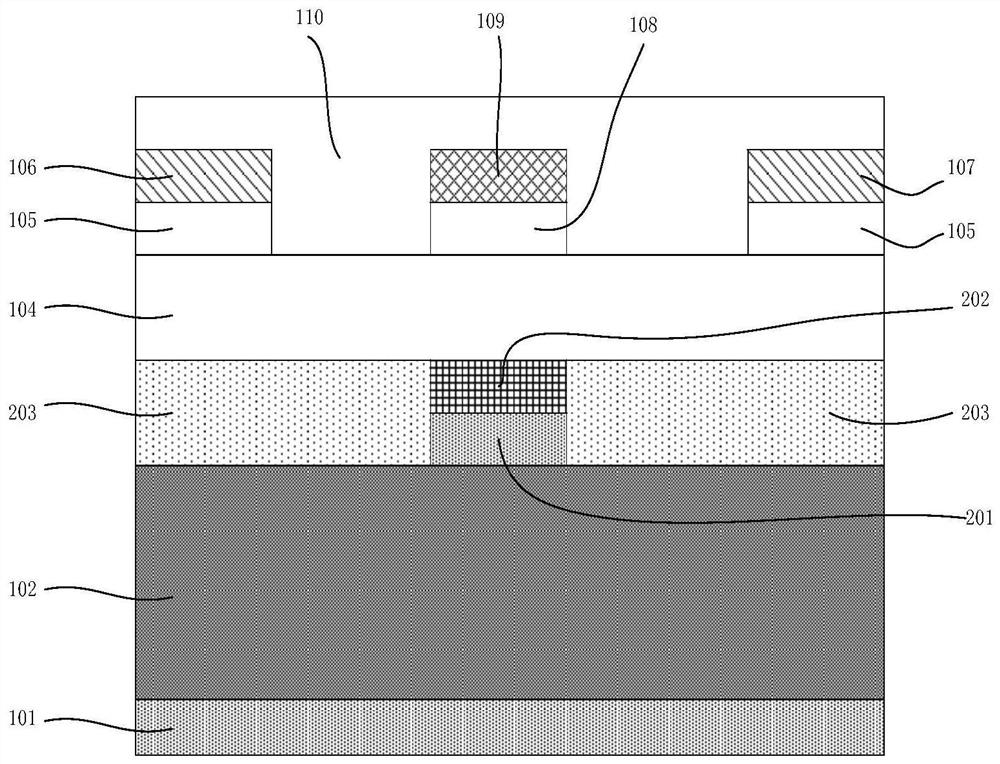Nitrogen-enhanced GaN-based Heterojunction Field-Effect Transistor with Composite Barrier Layer
A heterojunction field effect and composite barrier technology, which is applied in semiconductor devices, electrical components, circuits, etc., can solve the problems of high etching process requirements, degradation of device sub-threshold characteristics, and reduced device gate control ability, etc., to achieve Effects of avoiding defects, reducing polarization strength, and large saturation drain current
- Summary
- Abstract
- Description
- Claims
- Application Information
AI Technical Summary
Problems solved by technology
Method used
Image
Examples
Embodiment 1
[0035] like figure 2 As shown, a nitrogen-surface-enhanced composite barrier layer gallium nitride-based heterojunction field effect transistor in this embodiment includes: a substrate 101, a gallium nitride buffer layer 102 arranged on the upper layer of the substrate 101, a nitride Gallium nitride channel layer 104, source 106, drain 107, gate 109, N+ type semiconductor layer 105, passivation layer 110, composite barrier layer above the gallium buffer layer 102, the N+ type semiconductor layer 105 is set Above the gallium nitride channel layer 104, the source electrode 106 and the drain electrode 107 are arranged above the N+ type semiconductor layer 105 and both form ohmic contacts with the N+ type semiconductor layer 105, and the gate electrode 109 is arranged on the nitride Above the gallium channel layer 104, the composite barrier layer is arranged between the gallium nitride buffer layer 102 and the gallium nitride channel layer 104, and the composite barrier layer inc...
Embodiment 2
[0044] like image 3 As shown, the difference between this example and the first example is that an insulating dielectric layer 108 is disposed above the gallium nitride channel layer 104 , and the gate 109 is disposed above the insulating dielectric layer 108 .
[0045] The following will image 3 The shown nitrogen facet-enhanced GaN HFET with composite barrier layer and figure 1 The comparison of the conventional nitrogen-faced GaN HFET shown; the structural parameters of the device are given in Table 1 as an example.
[0046] Table 1 Device simulation structure parameter table
[0047] Device parameter name Conventional Nitrogen Surface GaN HFET Nitrogen surface GaN HFET of the present invention Gate length 0.62μm 0.62μm source length 0.5μm 0.5μm Gate-to-source spacing 0.05μm 0.05μm GaN buffer layer thickness 200μm 200μm barrier layer thickness 2nm 2nm GaN channel layer thickness 20nm 20nm AlGaN bar...
Embodiment 3
[0052] like Figure 4 As shown, the difference between this example and the second example is that the lengths of the GaN layer 201 and the AlGaN layer 202 are greater than the length of the gate 109 .
[0053] By increasing the length of the AlGaN layer and the AlN layer, the two-dimensional electron gas in the channel of the non-gate region can be further depleted. This scheme can further increase the device threshold voltage, but it will reduce The two-dimensional electron gas density of the channel leads to a decrease in the drain current when the device is turned on.
PUM
| Property | Measurement | Unit |
|---|---|---|
| thickness | aaaaa | aaaaa |
| thickness | aaaaa | aaaaa |
| thickness | aaaaa | aaaaa |
Abstract
Description
Claims
Application Information
 Login to View More
Login to View More - R&D
- Intellectual Property
- Life Sciences
- Materials
- Tech Scout
- Unparalleled Data Quality
- Higher Quality Content
- 60% Fewer Hallucinations
Browse by: Latest US Patents, China's latest patents, Technical Efficacy Thesaurus, Application Domain, Technology Topic, Popular Technical Reports.
© 2025 PatSnap. All rights reserved.Legal|Privacy policy|Modern Slavery Act Transparency Statement|Sitemap|About US| Contact US: help@patsnap.com



